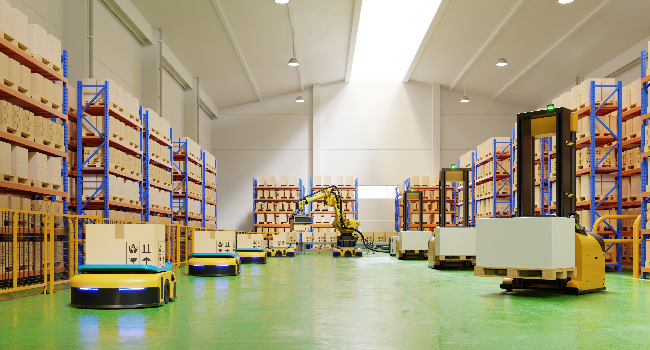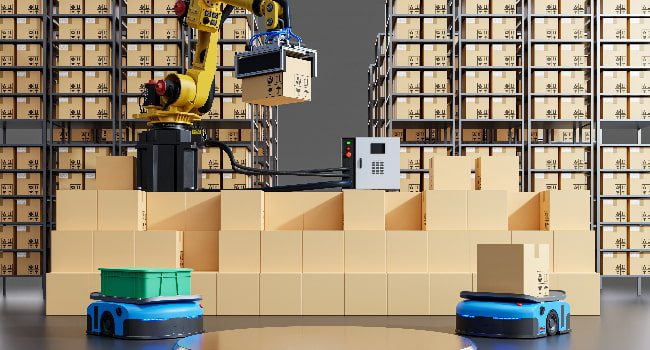A1 Quality Logistical Solutions
Key Highlights
- The blog explores the evolving landscape of lumper services in the logistics industry.
- Technological advancements like AI and automation are reshaping lumper services for enhanced efficiency.
- Regulatory changes and compliance issues are key factors influencing the future of lumper services.
- Economic trends and global trade policies have a significant impact on the demand for lumper services.
- The shift towards sustainable practices and green initiatives is transforming the way lumper services operate.
- Emerging markets and opportunities in e-commerce present new avenues for growth in lumper services.
Introduction
Lumper services are very important for smooth logistics operations. As the industry changes, these services also change with new technology, rules, and economic shifts. Knowing the history and spotting new chances can help improve the supply chain. It is vital to think about future problems and ways to solve them for lumper service providers. Keep an eye out for trends and forecasts that will affect the future of lumper services in the ever-changing logistics industry.
Evolution of Lumper Services in the Logistics Industry
At first, lumper services helped with manual labor for loading and unloading goods. Over time, they became more skilled and could handle different types of cargo well. This change happened because there was a need for better speed and efficiency in warehouse operations. Now, lumper services are very important for smooth logistics operations. They help ensure that goods are delivered on time and improve the supply chain overall. Looking ahead, lumper services are expected to see even more advancements in technology and processes, making them even better in the logistics industry.

How Lumper Services Have Transformed Warehousing and Distribution
The use of lumper services has changed how warehouses and distribution work. It has made operations more efficient and has cut down delays. Lumper services help with loading and unloading, which makes logistics operations smoother. This way, businesses can deliver goods on time and manage their inventory better. With this change, companies can focus on their main tasks while experts handle the physical goods. As a result, warehousing and distribution have become faster, more flexible, and cheaper. They can now meet the changing needs of today’s supply chains.
Technological Advancements Impacting Lumper Services
Using AI and machine learning is changing lumper services. It makes loading and unloading much faster and easier. Automation helps to improve how things are done in warehouses. By using these new technologies, lumper service providers can offer better quality and keep up with the changing needs in transportation services. These updates not only increase productivity but also help save money and make customers happy. This puts lumper services in a great spot for supply chain progress. To stay ahead and adjust to changes in the industry, it is important to welcome new technology.

Integration of AI and Machine Learning
AI and machine learning help loading and unloading tasks by predicting what is needed, improving speed, and lowering mistakes. AI looks at data patterns to make things smoother. Meanwhile, machine learning improves rules to help with better choices. The combination of AI and machine learning changes lumper services by providing easy-to-use predictions and smart insights, which you can’t get with old ways. The future of lumper services is about using these modern technologies to make logistics operations much more effective and efficient.
The Role of Automation in Streamlining Loading and Unloading Processes
Automated systems help make operations smoother, use warehouse space wisely, and speed up service. Robots and advanced software handle goods more accurately and quickly. These improvements not only increase productivity but also make the customer experience better. They help lumper services meet the needs of today’s supply chain operations. Using automation is essential to stay competitive in the changing world of logistics services.
Regulatory Changes and Their Impact on Lumper Services
Recent changes in regulations have greatly affected lumper services in the logistics industry. There are challenges about following the rules. Lumper providers need to adjust quickly. By facing compliance issues head-on, lumper services can work better and keep customers happy. Finding strong solutions to deal with these regulatory changes will be essential for the ongoing success of lumper service providers in the changing world of logistics operations.

Recent Regulatory Developments Affecting Lumper Services
In response to recent rules affecting lumper services, there is a clear move towards stricter compliance in the logistics industry. These changes aim to improve transparency, safety, and responsibility in how lumper operations are managed. Regulatory groups are paying more attention to standardizing practices and making sure workers in the lumper service area are treated fairly. For lumper service providers, keeping up with these changing rules is important to stay competitive and maintain a good reputation in the market. While compliance challenges can be tough, smart solutions and active steps can help manage these rules better.
Compliance Challenges and Solutions for Lumper Providers
- Navigating compliance challenges is very important for lumper providers.
- They need this to keep their operations smooth.
- Problems like labor rules and safety standards can create big obstacles.
- To overcome compliance gaps, they can set up strong training programs and regular checks.
- Using technology, like RFID tags for tracking inventory, helps with compliance.
- Working together with regulatory groups and industry partners is important to stay informed on changing standards.
- Keeping thorough records and documents is crucial to show they meet compliance rules.
- By tackling these challenges early, lumper providers can improve their service quality and reputation in the logistics industry.
Economic Trends Influencing Lumper Services
Changes in global trade rules can directly change how much people need lumper services. As economies grow and change, efficient supply chain operations become more important, boosting the need for lumper services. By looking at economic trends, lumper service providers can adjust and succeed even when the market shifts. The future of lumper services depends on keeping up with new economic trends to stay important and sustainable in the logistics world.

The Effect of Global Trade Policies on Lumper Services
Changes in tariffs, trade agreements, and import-export rules change how much lumper help is needed. Changes in global relationships can cause shipping amounts to rise and fall, which influences the demand for lumper services at distribution centers and warehouses. Service providers need to be quick and flexible to adapt to these new trade policies. This helps them run their operations smoothly and meet the needs of their customers as international trade changes. Understanding how global trade policies impact the logistics and supply chain environment is essential for success.
Analyzing the Demand for Lumper Services in a Fluctuating Economy
When the economy is uncertain, businesses often have different inventory levels and delivery methods. This directly affects how much they need lumper services. Additionally, businesses that are careful about costs might look for lumper services instead of paying fixed labor costs during tough economic times. It is important for lumper service providers to understand these changes in demand to improve their work and meet the changing needs of the market.
The Shift Towards Sustainable Practices in Lumper Services
Companies are working to lower carbon footprints and improve energy use. They are starting to use electric vehicles for transportation services. They also integrate renewable energy in warehouse operations. Focusing on sustainability helps the environment. It can also build a better image for the brand and attract customers who care about the environment. As the logistics industry changes, making sustainability a priority in lumper services is key for long-term success.

Implementing Green Initiatives in Logistics Operations
By using eco-friendly practices, we can optimize transportation routes, reduce carbon emissions, and use renewable energy sources. These changes in lumper services support a greener supply chain.
Using electric vehicles and following paperless processes can greatly help. Promoting recycling in warehouse operations is another effective way to lower our carbon footprint. Embracing these green initiatives not only helps the environment but also improves our brand’s reputation. It attracts customers who care about the planet too. In today’s world, focusing on sustainability in logistics operations is essential for long-term success.
The Importance of Sustainability in Future Lumper Strategies
As the logistics industry focuses on sustainability, lumper services aid in creating eco-friendly plans. Using sustainable practices cuts down on damage to the environment and improves a brand’s image. In the future, lumper strategies should focus on green actions to keep up with changing customer needs and rules. By adding sustainable practices to warehouse operations and transportation services, lumper providers can help create a supply chain that cares for the environment. Choosing sustainability in lumper services is not just a passing fad. It is needed for lasting success in the logistics field.
Emerging Markets and New Opportunities for Lumper Services
As businesses move into new economies, they need better warehouse operations and smooth logistics services. Lumper service providers can become leaders in supporting the changing supply chain by entering these new markets. This chance to use emerging markets is a great way for lumper services to succeed and make a big impact in the global logistics system.

Identifying Growth Areas: E-commerce and Beyond
With the growth of online shopping, lumper services are set to expand quickly. The rise in e-commerce needs fast and efficient order fulfillment and delivery. This trend gives many chances for lumper service providers. With more online shops and a greater need for better warehouse operations, lumper services can help many industries outside of e-commerce.
Expanding Lumper Services to Emerging Economies
By exploring new global markets, lumper service providers can meet the rising needs of logistics operations in quickly growing areas. Setting up in these economies helps improve supply chain efficiency. It also allows businesses to receive solutions that fit their unique needs. This growth builds partnerships with local businesses. It helps create strong supply chain networks and improves overall operational strength.
The Role of Lumper Services in Enhancing Supply Chain Efficiency
Lumper services help to connect transportation services and warehouse operations. They make sure things move smoothly and quickly. This reduces delays in the fulfillment process. Their role is key to achieving maximum efficiency in the entire supply chain.

Case Studies: Successful Integration of Lumper Services
In a recent study, a large logistics company added lumper services to its supply chain. This move helped them work faster and cut down on loading and unloading times. They placed lumper services at important warehouse locations. This made their fulfillment process smoother and allowed them to meet customer orders more efficiently. As a result, they not only improved their supply chain operations but also boosted customer satisfaction. This example shows how using lumper services can play an important role in improving warehouse management and supply chain performance.
Measuring the Impact of Lumper Services on Supply Chain Velocity
Measuring how lumper services help speed up the supply chain gives us important details about how well a business runs. By looking at how much time is saved when loading and unloading with lumper help, companies can make their supply chain operations better. Quick handling of freight with these services not only speeds up warehouse operations but also helps to improve transport schedules. This increase in loading speed makes the supply chain work faster. It allows goods to be delivered to customers on time and improves overall logistics performance.
Challenges and Solutions for Lumper Service Providers
Navigating labor shortages and skill gaps is difficult for lumper service providers. By adopting new ideas and training workers, lumper service providers can work better and meet the rising needs of the logistics industry. It is key to balance labor challenges with tech growth for lasting success in providing effective lumper services.

Navigating Labor Shortages and Skill Gaps
In the logistics industry, companies that provide lumper services face various challenges due to labor shortages and skill gaps. When the need for good loading and unloading services increases, it gets harder to find workers with the right skills. Using technology, like automation in warehouse operations, can help ease these shortages. Also, putting money into training programs for current workers can improve efficiency and close skill gaps. It is important for lumper services to adjust to the changing workforce so they can meet the new needs of the industry.
Technological Solutions to Traditional Lumper Service Challenges
Innovations in warehouse management software have changed how lumper services work. They make operations better and more accurate. Tools like robotic process automation (RPA) help with repetitive tasks. This reduces mistakes and speeds things up. Using AI-powered systems for inventory management helps keep stock levels just right and improves order fulfillment. Also, data analytics can predict demand patterns and improve how resources are used. By using technology in traditional lumper services, providers can deal with problems like having fewer workers. This also helps improve the quality of services. Using these tech solutions leads to smoother operations and better customer satisfaction.
Future Predictions for Lumper Services
Industry experts believe that lumper services will use new technologies like AI and automation to work better. They expect these services to connect more with warehouse management systems. This will help with real-time tracking and better organization. As supply chains change, lumper services are likely to adjust to new needs. They will offer environmentally friendly solutions and fresh ideas. The future may also bring unique offerings for different sectors, responding to the flexible world of logistics operations. By following these trends, lumper services could greatly improve supply chain management.

Industry Expert Insights on the Future of Lumper Services
As experts look at the future of lumper services, they see technology as the propelling force of changes to come. New tools like AI and automation will change how we load and unload goods. This will make the process faster and better. Also, green practices and sustainable choices are becoming more important in logistics. This means that lumper services will probably focus on being eco-friendly. With more and more people wanting smooth supply chain operations, lumper services must adapt to meet these needs well. All of this shows that lumper services have a bright future in the changing logistics world.
Projected Technological Innovations in Lumper Services
New tools in lumper services include better warehouse management software, automation that uses AI for easier loading and unloading, and machine learning to improve supply chain operations. These tools aim to make lumper services more efficient and accurate. This will create a smooth experience for logistics providers and their customers. It is important for lumper service providers to accept these changes to stay competitive and offer great service in the growing logistics field.
Conclusion
In conclusion, the future of lumper services in the logistics industry looks promising. This is because of new technology changes, updated rules, economic shifts, efforts for sustainability, new markets, and better supply chain efficiency. Lumper service providers will need to face challenges like labor shortages and skill gaps. It will be important to adopt new technology solutions. Experts say that there will be ongoing changes and improvements in lumper services. This will lead to better efficiency and greater customer satisfaction. By being quick to respond and adapting to changes in the market, lumper services will help shape the future of supply chain operations and logistics services.
Frequently Asked Questions
What Regulatory Changes Impact Lumper Services?
Recent changes in laws about work and safety affect lumper services a lot. Providers face problems following new rules while also keeping their operations running smoothly. They look for solutions to handle these changing regulations effectively.
Why Are Sustainable Practices Important for Lumper Services?
Sustainable practices are very important for lumper services. They help reduce harm to the environment, follow rules, and keep the business strong for the long run. By using green initiatives, they can work more efficiently. This also matches the increasing focus on sustainability in logistics operations.
How Can Lumper Services Improve Supply Chain Efficiency?
Lumper services can improve the supply chain by making loading and unloading faster. Using technology like automation and AI helps operations run smoothly. This cuts down on delays and boosts logistics performance. These improvements lead to a supply chain that is more agile and ready to respond.
What Challenges Do Lumper Service Providers Face Today?
Challenges that lumper service providers face today include a lack of workers, higher costs to operate, and the need to keep up with changing rules. New technology brings its own challenges for combining it into the current system. Also, there are new demands for being more sustainable. Overcoming these obstacles is very important for staying efficient and competitive in the logistics industry.

Haley serves as the Marketing Manager for A1 Quality Logistical Solutions. She joined A1QLS in 2023 with her prior experience gained with GXO and XPO Logistics.

